|
|
>>
New User Register 

Login Member:
|
|
|
|
| World's first movies on bird flu - This is the first part of bird flu the virus - This animated, 45 minute, movie arms you with detailed information on virus, it answers those questions that had been bothering you but did not know whom to ask?, like how can a "bird virus" infect human beings, How can the virus jump from chicken to humans? If this H5N1 virus has been present since 1997, why is there no medicine or vaccine available even today to fight it?
|
Bird Flu
- The virus movie Part 1:
Content : Disease
Type : Animation (advanced)
Duration : 45 minutes
The animation shows in details
the following
Topics Covered in Part 1 : - Seeing the real virus
- Viral structure, RNA, DNA
- Virus - a life form?
- How virus binds to a cell?
- Avian & human virus-basic
- Strains - shift, drift and recombination in detail
- Immune system - antibody action (basic concept)
- Specific nature of viral attachment
- Previous instances of virus jumping on to humans
- Influenza virus
- Influenza A, B, C difference
- Mechanism of infection of influenza virus
- Hemagglutinin & Neruraminidase action
- Classifying influenza A viruses
- Common Influenza viruses-human
- Common influenza viruses-birds
- Mutation example-H5N2
Available in Part 2 --
- How virus binds to a cell?
- Avian & human virus-detailed
- Strains - shift, drift and recombination in detail
- How bird virus infects humans
- Why spreading in Asia?
- Why pigs are mixing vessels
- Explanation based on sialic acids receptors and ciliated
epithelium
- Bird flu transmission
- -Direct from birds
- -through pigs (based on sialic receptors)
- -human to human transmission
|
|
|
|
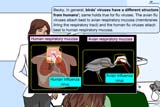 |
|
|
Mia shows the real virus to Sid
and Becky through electron microscope
|
Dr. Jenny elucidates the difference
between a bird flu virus and a human flu virus
|
Influenza viruses are of three types
A, B,C
|
|
|
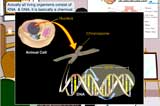 |
|
|
Jenny explains about H5N1 virus
|
Dr. Jones explain about the RNA/DNA
part of the virus
|
Mia tells Sid about the infection
process of a bird
|
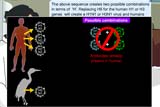 |
 |
|
|
Human and bird flu viruses combine
to create a new deadlier virus
|
Mutation of virus takes place in
a cell using reassortment creating its copies or virion
|
Dr. Jones clarifies the difference
between influenza and other viruses
|
|
|
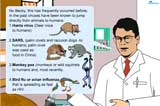 |
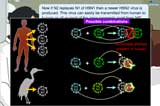 |
|
Becky learns why vaccines don't
work
|
Virus has
previous jumped to human beings from animals before
also
|
There are combinations for which
antibodies are present
|
|
There
are two parts of this movie both are sold separately, this
is the part 1, the part 2 deals with viral transmission
to humans.
Virus
is a strange entity it is "un-dead" and when it
comes in contact with a living cell it becomes alive and
causes diseases and deaths. This movie takes you onto a
journey of discovering the virus. The movie explains it
in an easy to understand, interactive format. It answers
many questions, some of them are given below. There are
two more movies on bird flu, go to their pages on our site
to get more details about this virus
Some of the Questions Answered
on Virus
1.What are influenza viruses? What do they look like ?
2.How are "bird flu" viruses different from "human
flu viruses"?
3.How are strains produced due to mixing of bird and human
viruses?
4.How does mixing of bird flu virus and human flu virus
take place?
5.Is the present instance of virus jumping from bird to
human a lone one?
6.Can a virus affect any type of cell whether human, plant
or an animal cell?
7.How big is a virus?
8.How is an entirely new virus strain created?
9.What is this antigenic shift and drift?
10.What are those spring like things inside the virus?
11.How do virus mutate?
12.What is meant by antigenic shift, drift and recombination?
13. Can you show us the attachment of bird flu virus to
human ciliated cells?
14.What is transmission mechanism of virus from human to
human?
15.How do they cause us harm, if the body can neutralize
them?
16. How can the virus "jump" from chicken to humans?
17.If this H5N1 virus has been present since 1997, why is
there no medicine or vaccine available even today to fight
it?
18.What is virus, what does it look like, how does it function?
Are they alive?
19.Can our body not recognize them as invaders and prevent
them from causing harm?
20.What is this influenza virus type A? What is this H and
N in H5N1?
|
|
|
|
|
| |
 by fujairah municipality
by fujairah municipality |
| |
|
|
|
|
|

